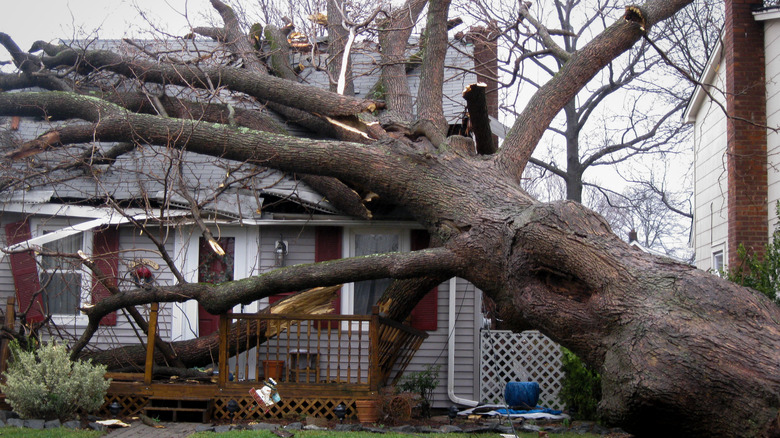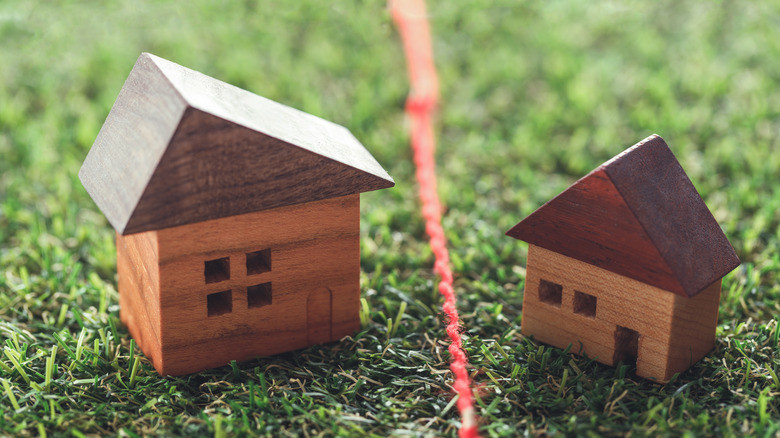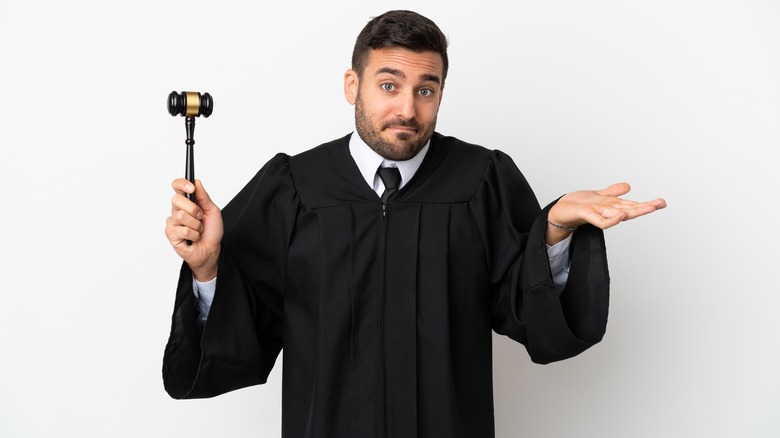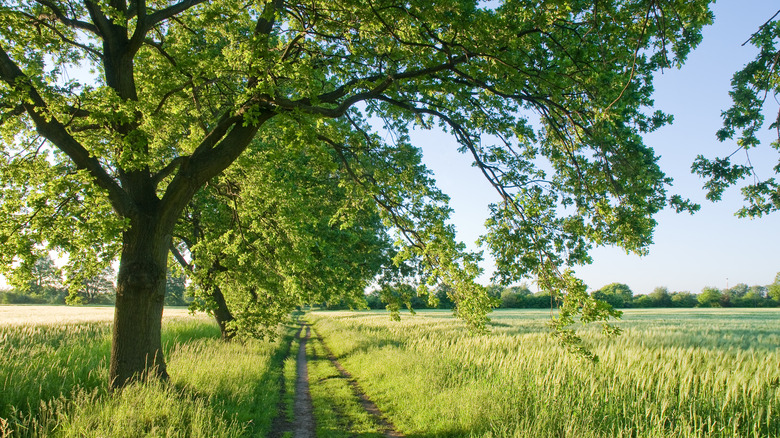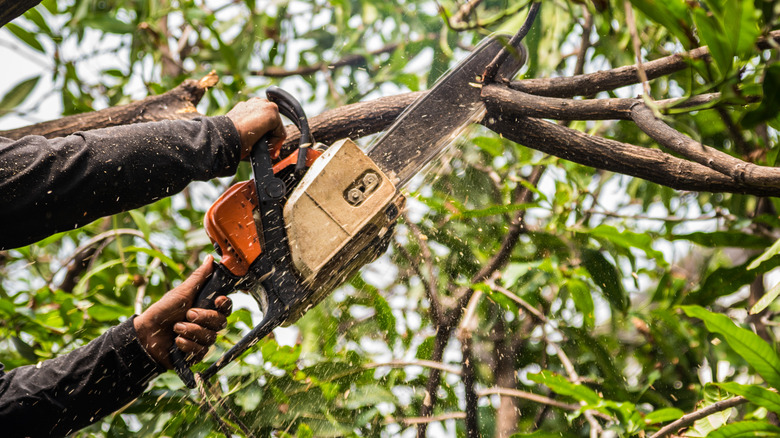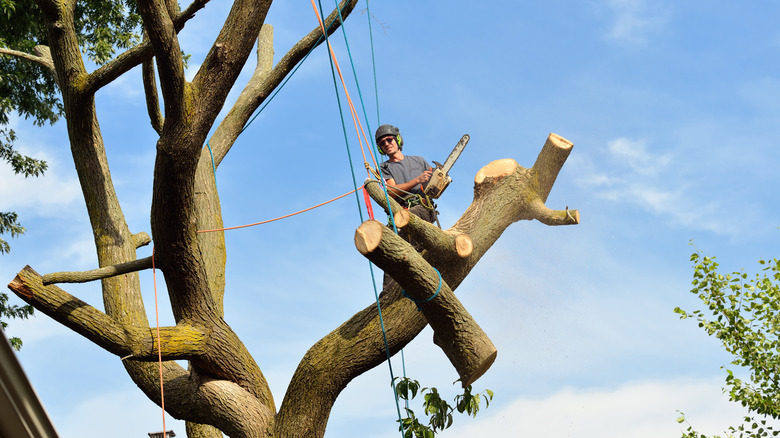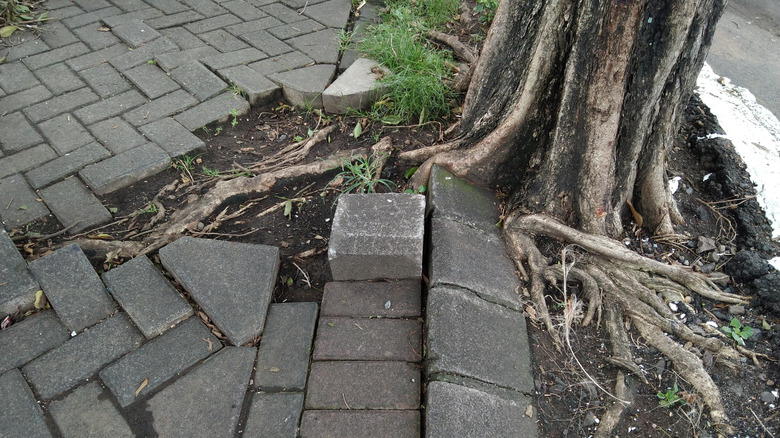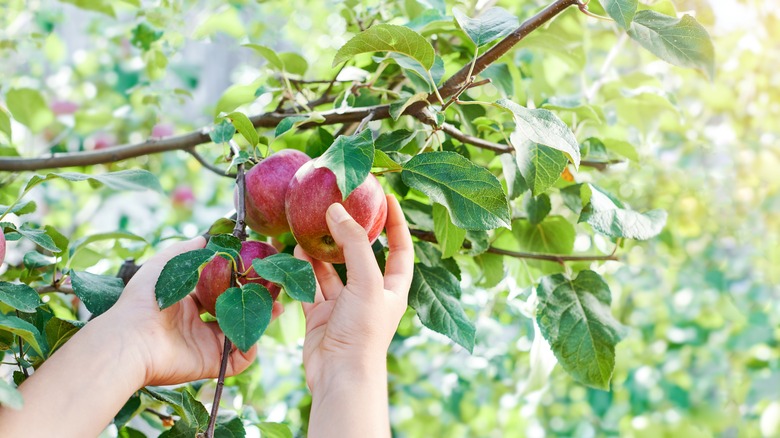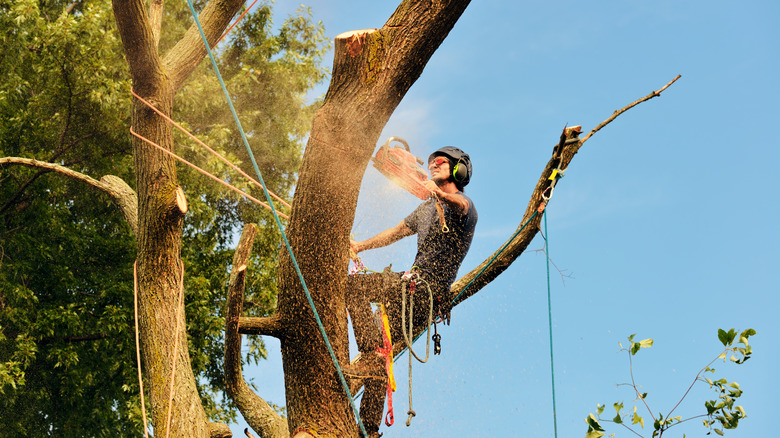Everything You Should Know About Trees And Property Lines In A Neighborhood
If you're about to do something to a tree that is anywhere near your neighbor's property, you might want to consult a lawyer or an arborist, or a lawyer-arborist if you can manage it. It's not that tree-related law is particularly complex or harsh. Laws about trees on property lines are usually pretty clear: You have a right to protect yourself from a tree... as does your neighbor. And you are responsible for and to any tree growing on your property.
In fact, law as it relates to trees and property rights seems to be mostly about applying common sense to heated situations. The presciently named Tom Root blogs at Tree and Neighbor Law Blog about, you guessed it, trees and neighbor law (or, as he puts it, about "Trespass, Encroachment, Property Lines, Nuisances ... and Getting Along"). His site is full of examples of the courts attempting to make sense of tree ownership and property lines by simply making sense. This has been expressed in many decisions and a handful of lasting precedents, most prominently a set of decisions named after their home states: the Massachusetts Rule, Hawaii Rule, Virginia Rule, and Modified Virginia Rule. A lot of rules exist because slight changes in circumstance drive what seems reasonable and fair. As Root points out, there is an old legal maxim holding that "hard cases make bad law," and the more details you absorb about any one case, the more reasonable it seems to tweak existing legal standards just a little, and eventually, things become quite confusing.
Disclaimer: Anything could happen
Let's say that you read a thorough, well-researched piece on the Internet that assured you of your rights regarding the tree that's threatening to drop limbs on your property, or your children or pets. The law is clear, the author proclaimed, that you have the right to protect yourself at the expense of that tree. And let's say the author is right about both the clarity and thrust of the law. This surely means you'll be able to prune the tree with impunity, right?
Not even slightly.
As evidenced by appeals courts, jury nullification, insane civil awards, and the like, almost anything can happen in an American court of law. Of course it's obviously better to follow the letter of the law, but since those laws are written and interpreted by people with their own experiences, preferences, and prejudices, it's always possible that something unexpected, or even apparently nonsensical, will happen and maybe make rather a mess of your financial future.
Tom Root calls the North Dakota Supreme Court's ruling in Herring v. Lisbon Partners "perhaps as fine a roundup on tree encroachment rules as has yet been written." In that opinion, the justices wrote that the Hawaii Rule, which holds that a tree's owner is responsible for a tree that creates or will imminently create danger or harm, is "the most well-reasoned, fair, and practical of the four generally recognized rules." And the Hawaii Rule seems to be the most broadly adopted modern approach, but if that seems to imply consistency in the courts, it shouldn't.
In 1988, the decision in Ridge v. Blaha advanced the most common view that if a tree's trunk grows on two properties, both parties are considered owners and must give permission for the removal of the tree. If it were only that simple.
The consistent inconsistency of court cases
To get a handle on just how confusing the legal landscape can be, let's take a look at a few cases advancing other stances, and perhaps illustrating the uphill battle you might confront. In Colorado in 1966, for example, the Supreme Court decided in Rhodig v. Keck that the common law understanding that trees growing on a property line are the joint property of the two property owners shouldn't keep one party from removing the trees if there is no agreement in place between the parties. Furthermore, the fact that one party originally planted and cared for the trees made no difference unless some such "agreement, right, estoppel or waiver" was in place.
In 1969, the Supreme Court of Minnesota found in Holmberg v. Bergin that without some agreement between the owners of adjoining land, a nuisance tree planted by one party and crossing the property line cannot necessarily be considered joint property. That is, one party planting a tree cannot force "involuntary tenancy in common of the tree upon his neighbor under which neither can remove or damage the tree without the consent of the other."
The 1989 decision by the New Mexico Court of Appeals in Garcia v. Sanchez adds an interesting dimension to these decisions by requiring that the plaintiff participate in remedying a problem. In this case, the plaintiff did not remark on the trees in question for the first eight years she owned her property, and the court held that she could not wait a decade to act and then determine she had the right to remove the trees in question.
The decisions in Rhodig, Ridge, Holmberg, and Garcia show that the behavior of a particular court cannot be predicted by dint of precedence or common law.
Boundary trees on a property line
All of those cases deal with one circumstance involving "boundary trees," which sit astride a property line and are by almost all accounts co-owned by those who own the adjacent properties. This ownership confers both rights and responsibilities to the owners. Before we look at the other possible situations, let's dig into the most common rules affecting boundary trees.
As we have said and FindLaw confirms, when a tree's trunk lies entirely on one party's land, the tree is that party's property. Otherwise, if the trunk is split by a property line, it is a boundary tree and is the mutual property of the two (or more, conceivably) landowners. Because of this, you cannot plant a tree on a property line without the permission of all future landowners and, in fact, you should try to plant trees 3-4 feet inside the property line to allow for growth and to stave off difficult-to-resolve legal issues (via Rocket Homes).
Failing to observe these "facts" could make you legally responsible for the monetary value of a damaged tree. In fact, in many jurisdictions, you can be held liable for up to three times the value of the tree. This value is defined by such factors as the tree's contribution to the property's value; any care expenses and/or removal costs for a damaged tree; and the replacement costs, including labor and cleanup, of the tree (via LawnStarter).
Trimming (and damaging) trees
All disputed trees don't grow on property lines, and though the property lines remain critical to determining how a tree-related conflict should be resolved. Your rights and responsibilities extend some distance into the air above and beneath the ground inside your property line, says LawnStarter. Imminent danger changes this equation a bit, and you might get away with encroaching on a neighbor's property to deal with it, but in most cases, your right to trim the branches (and, to some extent, roots) of someone else's tree stops at the property line, beyond which you're destroying someone else's property. Just remember that if you take on the responsibility to trim roots or branches on a tree you consider dangerous but which are otherwise your neighbor's responsibility, do so with care because you've just taken on liability for any aesthetic or real losses if you can't justify them in court (via Rocket Homes).
If you are held legally responsible for the damage it can add up to as much as three times the value of the tree. And what is the value of a tree? Well, it could be just about anything. In addition to replacement cost, diminished property value, and expenses incurred, some states explicitly quantify punitive damages for harming another's trees (and punitive damages are possible even without this provision). The tree owner's home insurance might cover part or all of the damage, but in a lawsuit, the plaintiff must deduct any insurance compensation from the amount sued for, unless the insurance company is to be repaid (via Nolo).
Falling branches, falling leaves, and other nuisances
In 2012, two-year-old Tripp Halstead was hit by a falling tree branch that crushed his skull and paralyzed him, says People magazine. After five years of struggle and recovery, he died as a result of his injuries. Trees add a lot to our lives, but they can be dangerous and have to be taken seriously. In the absence of negligence, most tree-related injuries or damage are generally considered an act of God and do not expose the tree owner to liability (via LawnStarter).
Legal responsibility for falling branches (and other nuisances) is determined by whether or not the tree's owner has met the common standard of care regarding the tree. This is sometimes determined by guessing the actions of a "reasonable person," which seems an overblown way to describe people who can't decide if you can eat a pear lying in your yard (more on this later). This reasonable person is "a fictional person with an ordinary degree of reason, prudence, care, foresight, or intelligence" (via FindLaw), which is fictional indeed, but the idea is clear enough: If it looked like a branch might fall, the owner should have dealt with it.
Whether a reasonable person could actually predict the things that expose them legally is a valid question, and one not often answered by the history of tree-related court cases. You could conceivably be sued for having a tree that's too tall, which seems to entirely miss the fact that trees are defined by their tallness and would otherwise be called shrubs, weeds, etc. (via Nolo). If this seems mad, you might take some comfort in the aforementioned efforts of the courts to apply common sense to these situations. You might take less comfort once you get your attorney's bill.
Sometimes, tree-related issues just aren't an issue. Leaves, for example, are a natural product and are, therefore, not the responsibility of the tree owner (via FindLaw). Yes, this is logically inconsistent with other standards regarding fruit, etc. The law is, famously, consistently inconsistent.
When a tree is a nuisance
Nuisance law is the area of law applicable to many situations involving trees that are dangerous, or even merely disruptive in some way. Cornell's Legal Information Institute defines a nuisance as "when the plaintiff's use and enjoyment of her land is interfered with substantially and unreasonably through a thing or activity." This remarkable bit of vagueness might seem like a bad foundation for law, but nuisance law has given many recourse without having the explicit protection of a million laws against every possible activity that is conceivably annoying to a neighbor.
Generally speaking, a nuisance tree is one that is causing (or likely to cause) physical damage (as, for example, a tree with roots disturbing a sidewalk), but this varies by jurisdiction and is often extended to include invasive or otherwise undesirable species, and can be as vague as "causes significant displeasure" or has "habits that cause it to be a problem for people" (via Law Insider), by which perhaps they mean profanity and public smoking. Here, again, the law becomes wildly subjective and uneven in its application; the common Bradford pear meets every one of these criteria, and some of them more than once, yet is found in lawns all over suburban America.
Picking (and picking up) fruit
What to do about fruit falling on a neighbor's (or from a neighbor's) tree is a question that comes up surprisingly often. In the best legal tradition, Findlaw finds that not saying anything definitive is the best path to accuracy in describing laws. You may have the right to pick fruit from your own fruit trees, or from trees in explicitly public spaces, picking fruit that overhangs your property might not be allowed even if trimming the trees is allowed. Any eight-year-old can tell you the workaround here: trim the entire fruit-bearing branch according to your legal right, but not any fruit directly. But, of course, taking legal advice from eight-year-olds is worse even than taking legal advice from lawyers. The truth is that it varies by jurisdiction and the mood of the judge on any particular day.
Writing for FindLaw, Brett Snider, Esq. advises that you ask your neighbors to collect their fruit, since it's impossible to predict the outcome of any possible legal action. Robert Rafii, another Esq., similarly advises that you might possibly have the legal right to pick fruit hanging above your own property, or even to eat fruit that has fallen on your property (via FindLaw).
Nolo author Jedediah Mannis describes a possible situation in which neighbors may not enter your property to retrieve their fruit, but you also aren't allowed to pick up fallen fruit yourself. He calls this "anomalous," which is a very polite way of putting it.
Tree removal
Sometimes, the best course of action regarding a problem tree is to remove it. There are a lot of ways to get this done. Some municipalities will remove trees, and utility companies will often (and unceremoniously) take down trees that are a threat to their equipment.
You could do it yourself if you have the equipment and training, but you probably shouldn't. According to research from Rutgers published in the American Journal of Industrial Medicine, arborists have one of the most dangerous jobs in America. American Arborists explains that this is particularly true when cutting down trees because of the training and experience necessary to predict and manipulate the effects of physics on the falling tree.
If you want to hire an arborist to do it for you instead, hold on to your hat; this can get pricey. The average arborist consultation runs between $75 and $150, and that's before anything at all productive has gotten done. The average cost of tree removal is $750 (via Home Advisor). A number of factors affect the actual cost of taking down a tree, including the height of the tree, its condition, the type of tree, the urgency of the removal's timing, access to the tree, and geographical location. Removing multiple trees and additional services like stump grinding, wood chipping, and logging add more to the cost (via Home Advisor).
Don't make it a legal issue
If you can find a way to keep your tree issues out of the courts, everyone will usually be better off. Unless one or both parties experience a religious revelation or some other reorganization of their thought processes, their future relationship is unlikely to recover from a lawsuit.
Nor will their pocketbooks recover quickly. Consider the case of Belle Terre Ranch v. Wilson, in which two wineries disputed access to an "avenue" between the properties. The vintner who won the case was awarded $1 in damages, and was billed $117,000 in legal fees that the loser did not have to pay (via Casetext).
American Arborists has a Q&A about handling tree conflicts among neighbors. Of their four answers, three of them advise the parties to speak calmly with each other and avoid involving lawyers if possible. This isn't just a way to keep your costs down; it's part of being a grownup, and it might also be a more productive path. Given attitudes about the courts and legal professions, does it really make sense to turn over such a sensitive issue to them... especially given that the results are somewhat unpredictable?
Research shows that having good relationships with your neighbors is an essential part of well-being in later life (via the Journals of Gerontology). Sure, you might choose to sit around fuming over a dispute involving an elm tree. But community is a key part of human life, and for better or worse, yours starts right on the other side of the property line... just past that old elm.
